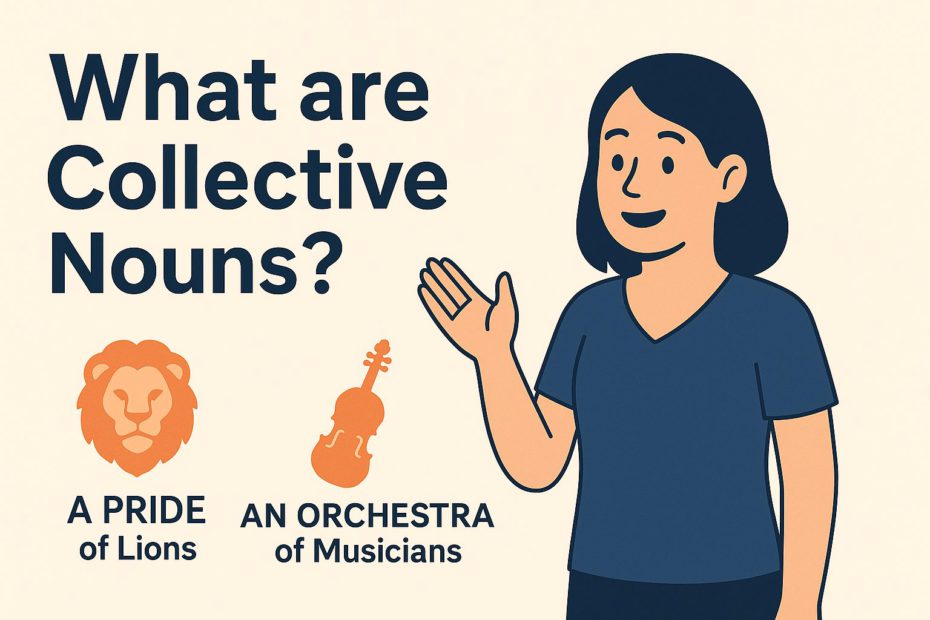Introduction
If you’re starting to learn English grammar, you’ll soon come across the term “collective nouns.” These words are common, but many people, even native speakers, find them confusing. Whether you’re new to English or just want to review, learning about collective nouns and determiners can help you speak and write more clearly. In this article, we’ll explain what collective nouns are, give lots of examples, and show you how to use them correctly. We’ll also talk about determiners in simple language, explain the different types, and share tips to help you avoid mistakes.
What Are Collective Nouns? Definition and Meaning
A collective noun is a word that names a group of people, animals, or things as one unit. Rather than naming each member, you can use a collective noun to talk about the whole group with a single word.
Examples of Collective Nouns:
- A flock of birds
- A team of players
- A herd of cattle
- A bunch of grapes
- A crowd of people
Collective nouns help make your writing more concise and your speech more efficient. Instead of saying “ten players,” you can simply say “a team.”
How Collective Nouns Work in Sentences
Collective nouns can be tricky because sometimes they use singular verbs and other times they use plural verbs. It depends on whether you mean the group as one whole or as separate people.
Examples:
- The team is winning the game. (team as a single unit)
- The team are arguing among themselves. (team members acting individually)
Tip for learners: In American English, collective nouns are usually treated as singular, while in British English, both singular and plural forms are common depending on context.
Common Collective Nouns in English
Here is a useful list of common collective nouns:
- Army (of soldiers)
- Class (of students)
- Family
- Committee
- Jury
- Staff
- Pack (of wolves)
- Bouquet (of flowers)
- Fleet (of ships)
- Swarm (of bees)
What Are Determiners? (Beginner-Friendly Guide)
When you learn about collective nouns, you will often see words like “the,” “a,” or “this” before them. These words are called determiners. Determiners go before nouns to show which person or thing you mean.
Why are determiners important? They help the person listening or reading know exactly what you mean. For example, “a team,” “this team,” and “my team” each have a different meaning.
Types of Determiners with Examples
English has several types of determiners. Here are some simple explanations and examples for each type.
1. Articles
Articles are the most common type of determiner. There are two types:
- Definite Article: The
- Indefinite Articles: A, An
Examples:
- The committee is meeting today. (definite article)
- A flock of sheep crossed the road. (indefinite article)
2. Demonstratives
Demonstratives point to specific things or people. The main ones are:
- This, That, These, Those
Examples:
- This team has won three championships.
- Those players are practicing.
3. Possessives
Possessives show that something belongs to someone. These include:
- My, Your, His, Her, Its, Our, Their
Examples:
- My family is visiting.
- Their group is performing tonight.
4. Quantifiers
Quantifiers show how much or how many there are. Some common quantifiers are:
- Some, Many, Few, Several, All, Most, Any
Examples:
- Some staff are absent today.
- Most of the jury agreed.
5. Numbers
Exact numbers can also be determiners.
Examples:
- Three packs of wolves
- Five teams competed
6. Distributives
Distributives talk about members of a group one by one or as a whole. The most common ones are:
- Each, Every, Either, Neither
Examples:
- Each committee member voted.
- Every family has traditions.
7. Interrogatives
Interrogatives are used to ask questions about nouns:
- Which, What, Whose
Examples:
- Which team won?
- Whose group is this?
Grammar Rules for Using Determiners
Here are some important rules and tips to keep in mind:
- Every noun needs a determiner (except for some plural or uncountable nouns in general statements).
- Use only one determiner per noun (e.g., “the my family” is incorrect).
- Order is important: If you use more than one determiner, the usual order is quantity or number, then article, demonstrative, or possessive, and then the noun (for example, “Three of my friends”).
- Do not use both definite and indefinite articles together (for example, do not say “a the group”).
Common Mistakes with Determiners (and How to Fix Them)
- Missing a determiner: “Family is coming.” → Should be “The family is coming.”
- Using the wrong type: “A my team” → Should be “My team.”
- Wrong order: “This every group” → Should be “Every group” or “This group.”
Tips for Learners
- Try using collective nouns with different determiners to see how the meaning changes. For example, “a team,” “my team,” and “that team.”
- Listen to native speakers or read English books and articles to see how determiners are used.
- Do not worry about making mistakes. Practicing is the best way to learn.
- Remember the context: Sometimes you can use either singular or plural verbs with collective nouns. Think about whether you mean the group as one or as separate people.
Conclusion
Collective nouns are useful in English grammar because they help you talk about groups easily. When you use them with determiners like “the,” “my,” or “some,” you can be clear and exact. Learning these basics will help you write better and feel more confident when speaking or studying English. Keep practicing with examples of determiners and collective nouns, and soon these grammar rules will feel natural.
